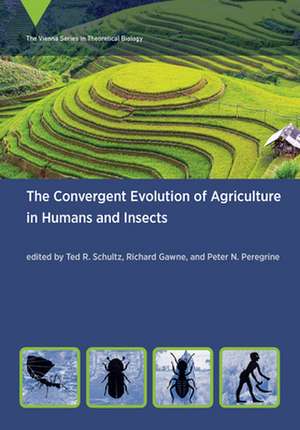The Convergent Evolution of Agriculture in Humans and Insects
Autor Richard Gawne, Ted R. Schultzen Limba Engleză Paperback – 22 feb 2022
Preț: 465.15 lei
Preț vechi: 540.88 lei
-14% Nou
Puncte Express: 698
Preț estimativ în valută:
89.01€ • 96.99$ • 75.00£
89.01€ • 96.99$ • 75.00£
Carte disponibilă
Livrare economică 02-16 aprilie
Livrare express 18-22 martie pentru 41.17 lei
Preluare comenzi: 021 569.72.76
Specificații
ISBN-13: 9780262543200
ISBN-10: 0262543206
Pagini: 352
Ilustrații: 54 black and white illustrations
Dimensiuni: 254 x 178 x 25 mm
Greutate: 0.71 kg
Editura: MIT Press Ltd
ISBN-10: 0262543206
Pagini: 352
Ilustrații: 54 black and white illustrations
Dimensiuni: 254 x 178 x 25 mm
Greutate: 0.71 kg
Editura: MIT Press Ltd
Cuprins
Series Foreword ix
Introduction 1
I Comparative Analyses of Human and Nonhuman Agriculture
1 Convergent Evolution of Agriculture in Bilaterian Animals: An Adaptive Landscape Perspective 7
2 The Convergent Evolution of Agriculture: A Systematic Comparative Analysis 31
II Conflict and Cooperation in Human and Nonhuman Agriculture
3 If Group Selection is Weak, What Can Agriculture Learn from Fungus-Farming Insects? 49
4 The Sociobiology of Domestication 61
5 Lifetime Commitment between Social Insect Families and Their Fungal Cultivars Complicates Comparisons with Human Farming 73
III The Diversity of Insect Agriculture
6 Fungus-Growing Termites: An Eco-Evolutionary Perspective 89
7 Mycangia Define the Diverse Ambrosia Beetle-Fungus Symbioses 105
8 Agricultural and Proto-Argicultural Symbioses in Ants 143
9 Plant Farming by Ants: Convergence and Divergence in the Evolution of Agriculture 161
IV Patterns of Convergence in Agriculturalists, Domesticates, and Parasites
10 Coevolution in the Arable Battlefield: Pathways to Crop Domestication, Cultural Practices, and Parasitic Domesticoids 177
11 Convergent Adaptation and Specialization of Eukaryotic Pathogens across Agricultural Systems 209
12 Evaluating Potential Proximate and Ultimate Causes of Phenotypic Change in the Human Skeleton over the Agricultural Transition 225
13 Hammond's Law: A Mechanism Governing the Development and Evolution of Form in Domesticated Organisms 257
14 The Convergent Evolution of Agriculture in Humans and Fungus-Farming Ants 281
Contributors 315
Index 317
Introduction 1
I Comparative Analyses of Human and Nonhuman Agriculture
1 Convergent Evolution of Agriculture in Bilaterian Animals: An Adaptive Landscape Perspective 7
2 The Convergent Evolution of Agriculture: A Systematic Comparative Analysis 31
II Conflict and Cooperation in Human and Nonhuman Agriculture
3 If Group Selection is Weak, What Can Agriculture Learn from Fungus-Farming Insects? 49
4 The Sociobiology of Domestication 61
5 Lifetime Commitment between Social Insect Families and Their Fungal Cultivars Complicates Comparisons with Human Farming 73
III The Diversity of Insect Agriculture
6 Fungus-Growing Termites: An Eco-Evolutionary Perspective 89
7 Mycangia Define the Diverse Ambrosia Beetle-Fungus Symbioses 105
8 Agricultural and Proto-Argicultural Symbioses in Ants 143
9 Plant Farming by Ants: Convergence and Divergence in the Evolution of Agriculture 161
IV Patterns of Convergence in Agriculturalists, Domesticates, and Parasites
10 Coevolution in the Arable Battlefield: Pathways to Crop Domestication, Cultural Practices, and Parasitic Domesticoids 177
11 Convergent Adaptation and Specialization of Eukaryotic Pathogens across Agricultural Systems 209
12 Evaluating Potential Proximate and Ultimate Causes of Phenotypic Change in the Human Skeleton over the Agricultural Transition 225
13 Hammond's Law: A Mechanism Governing the Development and Evolution of Form in Domesticated Organisms 257
14 The Convergent Evolution of Agriculture in Humans and Fungus-Farming Ants 281
Contributors 315
Index 317
Notă biografică
edited by Ted R. Schultz, Richard Gawne, and Peter N. Peregrine
